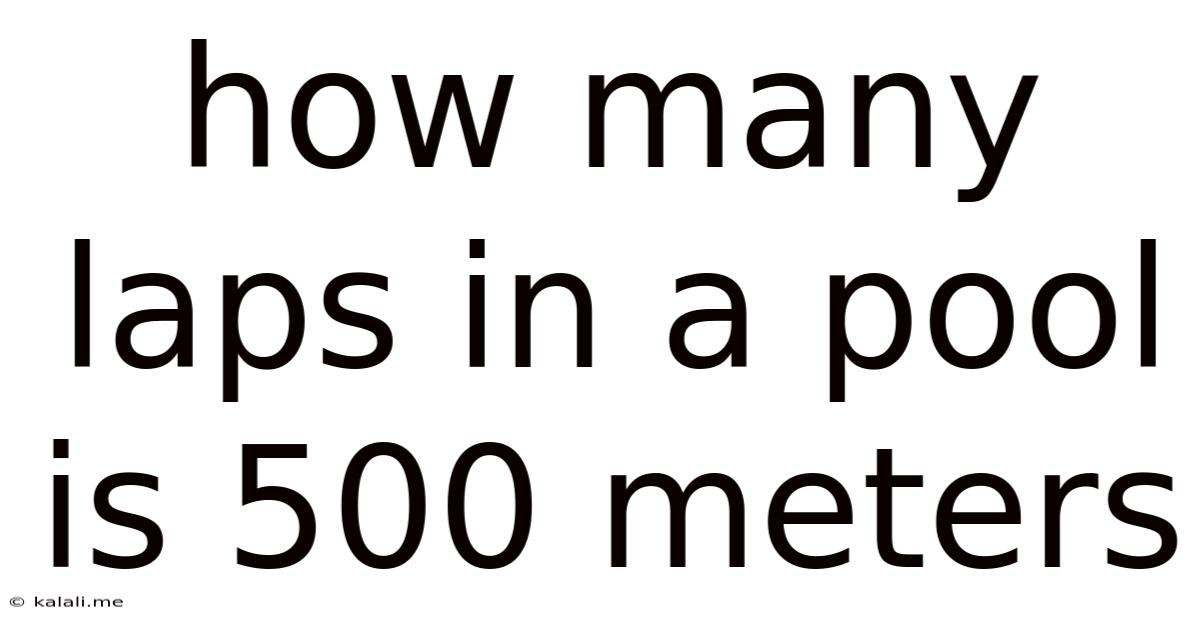How Many Laps In A Pool Is 500 Meters
Kalali
Aug 22, 2025 · 4 min read

Table of Contents
How Many Laps in a Pool is 500 Meters? A Comprehensive Guide
Swimming 500 meters is a significant distance, whether you're training for a competition, aiming for a fitness goal, or simply curious about the number of laps involved. This comprehensive guide will break down how to calculate the number of laps needed to achieve this distance, considering various pool lengths and common swimming scenarios. We'll also explore the factors that affect your lap count and offer tips to ensure accurate tracking.
Understanding Pool Lengths and Lap Calculations:
The key to determining the number of laps needed to swim 500 meters lies in understanding the standard lengths of swimming pools. The most common pool lengths are:
- 25-yard pools: Approximately 22.86 meters long.
- 25-meter pools: Exactly 25 meters long.
- 50-meter pools: Exactly 50 meters long.
The calculation is straightforward: you divide the total distance you want to swim (500 meters) by the length of the pool.
Calculations for Different Pool Sizes:
Let's break down the number of laps required for each common pool size:
- 50-meter pool: 500 meters / 50 meters/lap = 10 laps
This is the simplest calculation. Swimming 10 laps in a 50-meter pool will get you precisely 500 meters.
- 25-meter pool: 500 meters / 25 meters/lap = 20 laps
In a 25-meter pool, you'll need to complete 20 laps to reach your 500-meter goal.
- 25-yard pool: This requires a slightly more complex calculation because we need to convert yards to meters. Since 1 yard is approximately 0.9144 meters, a 25-yard pool is approximately 22.86 meters. Therefore: 500 meters / 22.86 meters/lap ≈ 21.87 laps.
Because you can't swim a fraction of a lap, you'll need to round up to 22 laps in a 25-yard pool to ensure you swim at least 500 meters.
Factors Affecting Lap Count:
While the calculations above provide a clear baseline, several factors can influence the actual number of laps you swim:
-
Pool lane markers: The lane markers aren't perfectly aligned. Slight variations in lane width can accumulate over multiple laps, leading to minor discrepancies in total distance. This variation is generally negligible for most purposes.
-
Turns: The turns themselves add a small amount of extra distance. While insignificant in the overall calculation, it's worth noting that you are swimming a slightly longer distance than the straightforward calculation suggests.
-
Push-off: The distance you cover in the initial push-off from the wall. This is highly variable depending on technique and strength.
-
Measurement inaccuracies: The pool itself might not be precisely 25 or 50 meters long. Minor variations in measurement can occur over time, especially in older facilities.
-
Individual swimming style: Differences in stroke technique and the distance covered per stroke will subtly affect the actual distance swum per lap.
Tips for Accurate Lap Tracking:
-
Use a pool lane counter: Many pools provide lane counters that automatically track the number of laps you complete.
-
Use a fitness tracker or smartwatch: Many wearables can track swimming distance accurately, providing a reliable measure of your progress.
-
Manually count your laps: If you don't have access to electronic tools, consistently counting your laps remains a reliable method.
-
Check the pool's signage: Always look for signage in the pool area confirming the pool's dimensions.
Swimming 500 Meters: Training Considerations and Benefits:
Swimming 500 meters is a significant undertaking, representing a considerable cardiovascular workout. Here are some training considerations and benefits:
-
Gradual Progression: If you're aiming to swim 500 meters continuously, start with shorter distances and gradually increase your workout duration and intensity.
-
Interval Training: Incorporating interval training with rest periods between swims is highly effective for improving endurance and speed.
-
Proper Technique: Mastering proper swimming technique is crucial for efficiency and injury prevention.
-
Cardiovascular Health: Swimming 500 meters provides a fantastic cardiovascular workout, improving heart health and overall fitness.
-
Muscle Strength and Endurance: It strengthens and builds endurance in all major muscle groups.
-
Calorie Burning: It's an efficient way to burn a significant number of calories.
Beyond 500 Meters: Advanced Considerations:
Once you've mastered swimming 500 meters, consider these advanced training strategies:
-
Increasing Distance: Gradually increase your swimming distance to challenge yourself further.
-
Improving Speed: Focus on improving your swimming technique and incorporating speed drills to enhance your pace.
-
Competitive Swimming: If you enjoy swimming, consider joining a swim club or participating in local competitions.
-
Different Strokes: Varying your strokes (freestyle, backstroke, breaststroke, butterfly) adds variety to your training and works different muscle groups.
-
Open Water Swimming: Transitioning to open water swimming offers a new set of challenges and rewards.
Conclusion:
Knowing how many laps equate to 500 meters is essential for effective swimming training and planning. Remember to factor in pool length, and always prioritize proper technique and safety. Whether you're aiming for personal fitness goals or competitive success, consistently tracking your progress will keep you motivated and on track to achieve your swimming aspirations. Remember to always prioritize safety and listen to your body. Consult with a healthcare professional or certified swimming instructor before starting any strenuous exercise program. Enjoy your swim!
Latest Posts
Latest Posts
-
How Do You Say Happy Birthday In Haitian Creole
Aug 22, 2025
-
How Many Days Are In 10000 Hours
Aug 22, 2025
-
Radians Per Second To Meters Per Second
Aug 22, 2025
-
If You Are Born In 1993 How Old Are You
Aug 22, 2025
-
How Many 16x16 Pavers For A 10x10 Patio
Aug 22, 2025
Related Post
Thank you for visiting our website which covers about How Many Laps In A Pool Is 500 Meters . We hope the information provided has been useful to you. Feel free to contact us if you have any questions or need further assistance. See you next time and don't miss to bookmark.